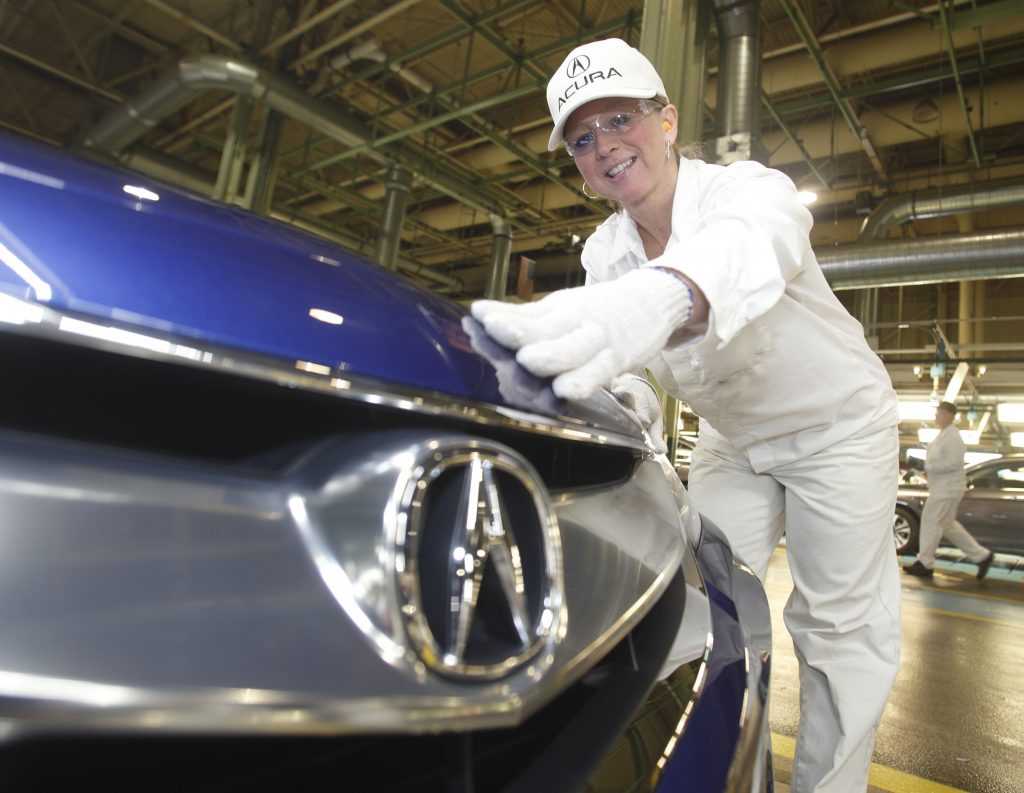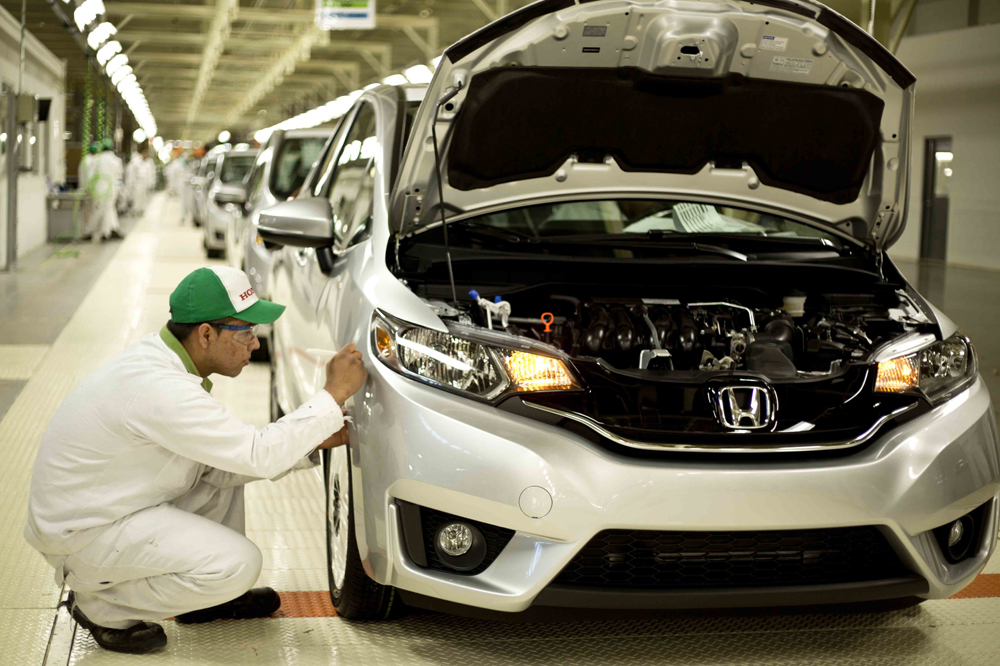 Over the course of some combined 60 years at Honda, Kevin Wade (left) and Dana McBrien (right) have had a huge influence on the carmaker’s logistics systems. And they are not done yet...
Over the course of some combined 60 years at Honda, Kevin Wade (left) and Dana McBrien (right) have had a huge influence on the carmaker’s logistics systems. And they are not done yet...
It takes longer to till some kinds of soil than others. Creating a more integrated logistics network and department for Honda in North America has taken more than 30 years, and work is not yet complete. That is not surprising given how much Honda has grown and changed in that period, first entering the US market as a two-wheeler manufacturer, before launching car assembly on a mostly knockdown kit basis in 1982.
In terms of management, systems and processes, Honda’s North American logistics is unique compared to its global operations. In Japan, Honda does not directly control its inbound logistics; the plant sets delivery windows, and suppliers deliver the goods to the gate (it is the same for Toyota). In a relatively small country where most suppliers are located close to plants, this approach has worked. But in North America, where distances are longer, and supply chains more complex, tighter control is necessary.
In this story...
Thus, while Japanese components might just need to be unpacked and put on the assembly line, fewer logistics systems and processes could easily be imported for the US, requiring local teams to develop much from scratch. It’s a process that continues today, with North America influencing global operations. The North American logistics team, for example, is now more involved in import and export processes that might previously have been controlled out of Japan, including influencing how parts are ordered and shipped, as well as participating in negotiating global container shipping contracts.
McBrien and Kevin Wade, both of whom started at Honda in the mid-1980s, are among those that have helped shape Honda’s supply chain and logistics at nearly every turn. McBrien, who has a background in finance and accounting, started in manufacturing in 1984 before moving to purchasing in 1986, where he worked for many years. “At the time we were going through a lot of localisation and I had a touch point with what seemed like every single new supplier in the US to work on their start up,” he says.
Wade, who got his degree in transportation logistics at Ohio State, started at Honda while he was still at university in 1985, first in the plant before moving into purchasing alongside McBrien. Back then, Honda didn’t really have a logistics function and purchasing managers had to follow up the material delivery. “When we started in purchasing, there was no logistics, it was all done by suppliers and paid in the [part] piece price,” says McBrien. “We didn’t know what was coming in when, it was sporadic and uncontrolled.”
Both would later play important roles in building Honda’s enterprise resource planning (ERP), manufacturing resource planning (MRP) and other supply chain IT systems, where again there was little to precede them. “Coming out of college, I assumed that Honda would have all these tools that I learned about, including EDI [electronic data interchange] with suppliers, MRP systems, etc.,” says Wade. “We didn’t have any of that. Everything was done on paper.”
McBrien and Wade would go on to write or specify many business systems still used today, including those for build-out processes, design change management, returnable container and parts tracking. Later, they were involved in choosing a more advanced ERP system from an IT provider, which improved supplier connectivity through EDI and label scans, and fostered more accurate receiving, inventory movements and visibility. After running this system for ten years, Honda used it as a template for a new, in-house system, which Wade helped to implement.
The two would eventually move directly into logistics, forming a team that consolidated flows that had until then been separate, even for neighbouring Marysville and East Liberty. A major step came in 1998 when Honda installed a crossdock in East Liberty, its first and still largest such facility.
That was the beginning of more coordination across the network, although it was still somewhat limited by the time McBrien took over logistics responsibility in 2002. “Even then logistics was very splintered. We had one faction that owned transport, another that owned domestic transport, and another for import suppliers,” he says. “It was a catastrophe waiting to happen.”

Honda eventually contracted Ceva Logistics (then known as TNT) as an LLP, which was arguably the foundation for a more integrated network. Ceva’s role has been to supplement Honda’s logistics team with both manpower and systems, taking the lead on areas including route engineering, transport analysis, material follow up, expedites, and freight payment auditing. What began as around five people supporting Honda is today 44 embedded staff with the North American logistics team in Marysville, as well as in several plants. The Ceva employees wear white, Honda-branded jumpsuits, making them indistinguishable from in-house staff.
An important part of this integration was the central inclusion of most logistics flows and services into a freight payment system. “A lot of things came together at the right time, including implementing the LLP, crossdocks across North America, as well as a freight payment process that moved us from paying carriers with paper to a really electronic, three-way matching accounts payable system,” says Wade. “We took a very manual transportation system and modernised it.
Today, Honda uses the system to pay for the majority of its logistics services, with some exceptions in Canada. It is in the process of including shipments in or from Mexico to the payment function.
The LLP and freight systems were fundamental, but importantly did not devolve decision-making and expertise from Honda. The outsourcing stops short of a ‘4PL’ arrangement, as Ceva carries out data analysis, consulting and some execution, while Honda’s logistics teams make purchasing, carrier and network decisions. When there are issues with carriers, whether in performance or financials, it is Honda that steps in, not Ceva. Honda also pays directly for operations in the freight system, rather than via the LLP.
As Honda has grown, its LLP-supplemented logistics department has been able to absorb more tasks. The Greensburg, Indiana plant, which opened in 2008, never established a local logistics function and has been supported entirely by North American logistics. While there are still local teams at other plants, including in Canada and Alabama, the central team oversees most routes, including nearly all the consolidated flows, which are by far the most complex, as well as returnable packaging.
 While the launch of the Celaya plant required dedicated resources in Mexico, North American logistics was closely involved in setting up processes and contracts there, while directly managing material originating north of the border.
While the launch of the Celaya plant required dedicated resources in Mexico, North American logistics was closely involved in setting up processes and contracts there, while directly managing material originating north of the border.
For example, Honda uses a Ceva application to assist material flow in and out of Mexico, which creates electronic releases for tier two suppliers moving parts northbound to tier one suppliers, and commercial invoices for Mexican authorities for southbound parts. “We didn’t have the capacity for all these logistics needs in-house as we expanded in Mexico, and Ceva was able to bridge that gap,” says Wade.
Honda is turning to its LLP for expertise and help beyond North American borders as well. The specialised assembly of the Acura NSX sports car, which will start later this year in Marysville (funnily enough at a site converted from Honda North American Logistics’ former head office), has introduced new global suppliers into Honda’s supply chain, including out of Europe. After initial attempts to establish an export centre run by the carmaker in the UK, Honda ultimately turned to Ceva’s extended global network to move the material.
Since putting these resources and systems in place, Honda’s logistics managers can also better understand and react to changes. A good example came this past winter during the latest round of labour disputes at west coast ports, which could have been even worse for Honda than it was, considering the carmaker uses the port of Los Angeles and Tacoma, Washington for almost all of its imported content. One advantage was that Ceva had access to warehouses in the Pacific north-west and in the south-west; it drayed containers that could be unloaded at ports to these sites, as well as to Honda’s import parts centre in Marysville, where material could be sorted and expedited to plants.
“Ceva really did a great job for us during the west coast slowdown with the drayage of containers off the port and trans-loading to trucks or airplanes,” Wade says. “We couldn’t do much about the containers stuck at sea or in Japan, but at least on our side we were prepared.”
Influencing supply chain design
 As part of gaining more central oversight in North America, Honda has made major improvements over the past 13 years in understanding total landed cost decisions. When McBrien inherited logistics in 2002, there was no established process for calculating potential logistics costs in Honda’s parts sourcing. “We noticed straight away for some commodities that the logistics costs must be outweighing any piece-price savings,” he says. “We rectified that by at least developing a simple calculator for purchasing to use, and we have steadily tried to grow that process to get them the right data.
As part of gaining more central oversight in North America, Honda has made major improvements over the past 13 years in understanding total landed cost decisions. When McBrien inherited logistics in 2002, there was no established process for calculating potential logistics costs in Honda’s parts sourcing. “We noticed straight away for some commodities that the logistics costs must be outweighing any piece-price savings,” he says. “We rectified that by at least developing a simple calculator for purchasing to use, and we have steadily tried to grow that process to get them the right data.
“It’s not easy in a central sourcing location, where you might handle 4-5 model changes, to keep all that balanced, but we have come a long way in developing those tools,” he adds.
While the department has certainly progressed, McBrien does not pretend that Honda has a complete supply chain management function yet. Many of the things that can impact logistics efficiency, such as parts ordering, sourcing and programme planning are still controlled by other departments or plants. Schedules may vary significantly from day to day; as Honda has a lot of cross-production of models and components in North America, these swings risk creating supply imbalance at certain plants if not considered carefully. Some of these issues are also systems-related: Honda currently builds truckloads for individual plants, as its systems struggle to consolidate multi-plant material on truck routes.
Other issues are process-related. Honda’s monthly engineering cycle reflects its sales operations and planning, which is updated at length each month. If McBrien had his way, he would do engineering changes every week, which would cut down variability in production for each model.
“In the monthly cycle we may front load, or back load specific units based on inventory, but it becomes difficult,” admits McBrien. “We want a rapidly moving supply chain, but that becomes harder with such wide variability.”
In some cases, decisions are still made without consideration for the impact across the network. For example, Honda’s logistics and packaging costs are attributed to the receiving plant, rather than to the total outsourced cost of the supplier part. Cost evaluators may focus on rising transport and packaging costs without measuring potential decreases elsewhere in the supply chain. McBrien has advocated that Honda should allocate all logistics costs, including in-plant material handling right up to the consumption point on the assembly line, to the outsourced part costs. “Sourcing drives packaging, transportation and material handling,” he says. “If you source in Mexico, we are going to handle it differently, for example. The idea is to get all of those costs and considerations together to better measure your decisions.”
It is too soon to say whether or not such internal changes will occur, including more controversial moves towards central parts ordering for plants (something that McBrien admits makes plant managers nervous). Regardless, McBrien and Wade aim to increase the influence that logistics has on model, plant and sourcing decisions.
Already, there are signs of progress. One example is that when Honda was considering moving the Acura ILX from its plant in Greensburg, Indiana, which it eventually did to Marysville this year, McBrien was tasked with modelling the supply chain implications. “We showed our management how much it would cost in logistics to move the model to another plant, what the cost impact would be for the model that remained at Indiana, the costs for models at other plants, and then the total savings,” says McBrien. “You wouldn’t believe the look on everyone’s faces when I showed them how a model in Indiana could impact a plant in Alabama. That was an important step in educating the company further.”
McBrien and his team are also getting more involved in making decisions about how material handling areas should be designed in plants, consolidation centres or off-site shared logistics centres. Under McBrien’s recommendation, for example, Honda brought back the packing and sorting for most in-line sequencing from supplier sites to one of its plants in the consolidation centre, which helped to increase accuracy and free up space and resource capacity at suppliers.
Currently, several of Honda’s plants have also requested more space to carry out handling and sorting. McBrien points out that building areas at each plant could make them less flexible, as the space will be locked to the plants. A more common solution might be more advantageous.
“Even though we don’t own the final delivery function, we are looking at how we can bring those parties to the table and use shared, common space, which can impact the final arrival point, as well as how parts flow within the facility, and how much processing it requires before arriving at the line,” he says. “In other words, we are attempting to provide an end-to-end solution.”
Click here to read part 4 in our Honda series, "At the centre of change". (Published July 16th)

























![Global[1]](https://d3n5uof8vony13.cloudfront.net/Pictures/web/a/d/s/global1_726550.svgz)









